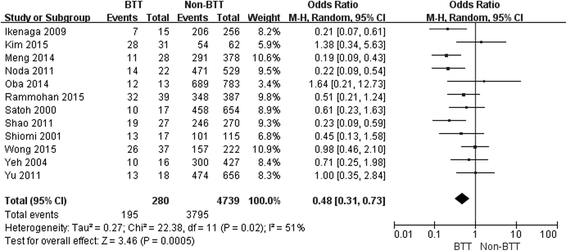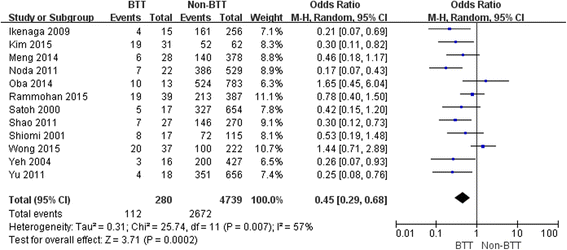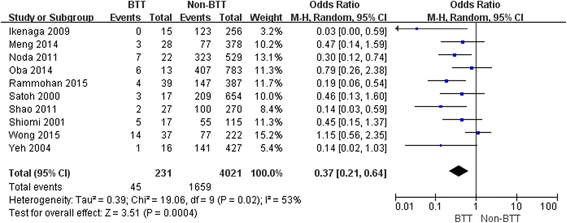Surgical outcomes of hepatocellular carcinoma with biliary tumor thrombus: a systematic review
- PMID: 26822229
- PMCID: PMC4730620
- DOI: 10.1186/s12876-016-0427-2
Surgical outcomes of hepatocellular carcinoma with biliary tumor thrombus: a systematic review
Abstract
Background: Hepatocellular carcinoma (HCC) with biliary tumor thrombus (BTT) is rare and its impact on postoperative prognosis remains controversial. The aim of this study was to evaluate the published evidence concerning the outcome of surgical resection of HCC with BTT.
Methods: Eligible studies were identified by searching PubMed and reviewed systematically. Comparisons of the clinicopathologic features and surgical outcomes for HCC patients with or without BTT were analyzed using meta-analytical techniques.
Results: Twenty retrospective studies containing 598 patients that met the selection criteria were included for review. The perioperative mortality was 2.1 % (range, 0-10 %), and the median 5-year overall survival (OS) was 24 % (range, 0-48 %) with a recurrence rate of 63.9 % (range, 42-91 %). Pooled analysis of 13 comparative studies showed that HCC patients with BTT had a higher incidence of vascular invasion (odds ratio [OR]: 4.70, 95 % CI: 2.90-7.60; P <0.001), a higher frequency of poor differentiation (OR: 2.07, 95 % CI: 1.23-3.49; P = 0.006), and a shorter 5-year OS rate (OR: 0.31, 95 % CI: 0.21-0.64; P <0.001) than those without BTT.
Conclusions: Although HCC with BTT has more aggressive biological characteristics and is an indicator of poor prognosis, surgical resection can still provide long-term survival for some patients.
Figures
Similar articles
-
Ablative and non-surgical therapies for early and very early hepatocellular carcinoma: a systematic review and network meta-analysis.Health Technol Assess. 2023 Dec;27(29):1-172. doi: 10.3310/GK5221. Health Technol Assess. 2023. PMID: 38149643 Free PMC article.
-
Management of people with early- or very early-stage hepatocellular carcinoma: an attempted network meta-analysis.Cochrane Database Syst Rev. 2017 Mar 28;3(3):CD011650. doi: 10.1002/14651858.CD011650.pub2. Cochrane Database Syst Rev. 2017. PMID: 28351116 Free PMC article.
-
Systematic review: the prognostic role of alpha-fetoprotein following liver transplantation for hepatocellular carcinoma.Aliment Pharmacol Ther. 2012 May;35(9):987-99. doi: 10.1111/j.1365-2036.2012.05060.x. Epub 2012 Mar 20. Aliment Pharmacol Ther. 2012. PMID: 22429190
-
[Comparison of the efficacy of anatomical resection versus hepatic parenchymal preservation preference in patients with solitary small hepatocellular carcinoma and cirrhosis: a multicenter retrospective study].Zhonghua Gan Zang Bing Za Zhi. 2025 Apr 20;33(4):348-358. doi: 10.3760/cma.j.cn501113-20250315-00097. Zhonghua Gan Zang Bing Za Zhi. 2025. PMID: 40419370 Chinese.
-
Impact of residual disease as a prognostic factor for survival in women with advanced epithelial ovarian cancer after primary surgery.Cochrane Database Syst Rev. 2022 Sep 26;9(9):CD015048. doi: 10.1002/14651858.CD015048.pub2. Cochrane Database Syst Rev. 2022. PMID: 36161421 Free PMC article.
Cited by
-
A single institution report of 19 hepatocellular carcinoma patients with bile duct tumor thrombus.J Hepatocell Carcinoma. 2017 Mar 7;4:41-47. doi: 10.2147/JHC.S126308. eCollection 2017. J Hepatocell Carcinoma. 2017. PMID: 28331844 Free PMC article.
-
Phase Attention Model for Prediction of Early Recurrence of Hepatocellular Carcinoma With Multi-Phase CT Images and Clinical Data.Front Radiol. 2022 Mar 24;2:856460. doi: 10.3389/fradi.2022.856460. eCollection 2022. Front Radiol. 2022. PMID: 37492657 Free PMC article.
-
A nomogram based on combining systemic and hepatic inflammation markers for predicting microscopic bile duct tumour thrombus in hepatocellular carcinoma.BMC Cancer. 2021 Mar 12;21(1):272. doi: 10.1186/s12885-021-07956-9. BMC Cancer. 2021. PMID: 33711965 Free PMC article.
-
Postoperative Adjuvant Transarterial Chemoembolization Improves Short-Term Prognosis of Hepatocellular Carcinoma with Bile Duct Tumor Thrombus: A Propensity-Score Matching Study.Cancer Manag Res. 2020 Sep 28;12:9183-9195. doi: 10.2147/CMAR.S270467. eCollection 2020. Cancer Manag Res. 2020. PMID: 33061610 Free PMC article.
-
CHEK2 SNPs predict better prognosis in HBV-related hepatocellular carcinoma patients.Int J Clin Exp Pathol. 2018 Jun 1;11(6):3165-3175. eCollection 2018. Int J Clin Exp Pathol. 2018. PMID: 31938446 Free PMC article.
References
-
- Zhou YM, Yang JM, Li B, Yin ZF, Xu F, Wang B, et al. Risk factors for early recurrence of small hepatocellular carcinoma after curative resection. Hepatobiliary Pancreat Dis Int. 2010;9:33–7. - PubMed
Publication types
MeSH terms
LinkOut - more resources
Full Text Sources
Other Literature Sources
Medical
Miscellaneous





